The 10 Best Wave Pools for Stellar Surfing on Demand
Every surfer knows the frustration of commuting to a remote surf location only to arrive and find the swell is, well, dead in the water. The lucky ones also know the supreme elation of paddling into a perfect wave, traveling through the green room and sucking the marrow out of a hollow tube before being spat out in a rush of saltwater and endorphins. That glorious feeling is what will drive us to the ends of the earth in search of the perfect wave. It’s also what has spurred a fascination with—and the explosion of—wave pools over the past decade.
In the world’s best wave pools, surfers are no longer tied to the whims of mother ocean. We can simply book a time slot, pay the entry fee, and surf perfect barrels on repeat in locations that don’t require expensive and sea-sickening boat trips. Check out this list of the world’s 10 best wave pools for an epic surf session, guaranteed.
10 Best Wave Pools for Surfing
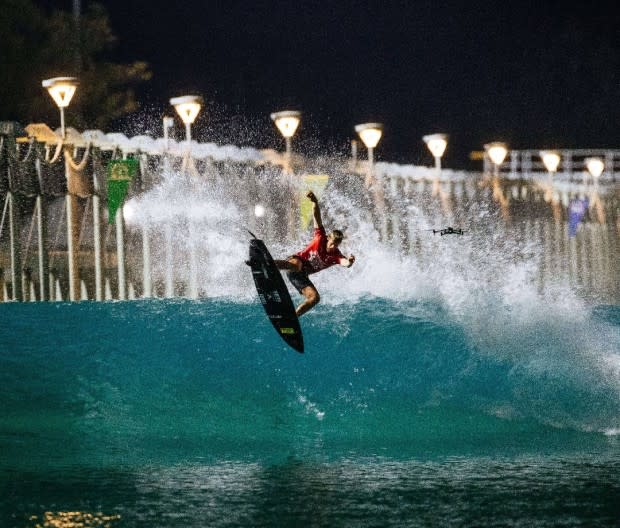
IMAGO/ZUMA Wire
Lemoore, CA
Eleven-time world champion Kelly Slater broke the internet and blew the collective minds of the surfing community when he debuted the vision of his Surf Ranch in 2015. Already a god to most surfers, Kelly had been playing god with water. He unveiled something no natural ocean swell had created before: a perfectly peeling, 50-second cylindrical barrel ride in the four- to six-foot size range with no interruptions.
Kelly’s 2,000-foot long, 500-foot-wide pool made the first mechanically produced wave and is still arguably the best. It’s the only one worthy of a World Surf League (WSL) Championship Tour event, the Surf Ranch Pro, held in May. You’ll find it hiding about 100 miles inland from the coast in Lemoore, CA—not exactly a beach town—pumping out 12 flawless lefts and rights every hour.
Surfers ride for a full leg-burning minute, then hop on the back of a jet ski to tow back to the start. There’s a clubhouse, hot tub, fire pit, and restaurant on site. Sounds too good to be true? It sort of is. The Surf Ranch is reserved for training, video clips, WSL contests, and VIPs only. Some online sources say you can book the pool for a private session, starting at a bare cost of $50,000 per day. To be fair, you could spend that much traveling the world in a lifetime and never surf as perfect a wave.
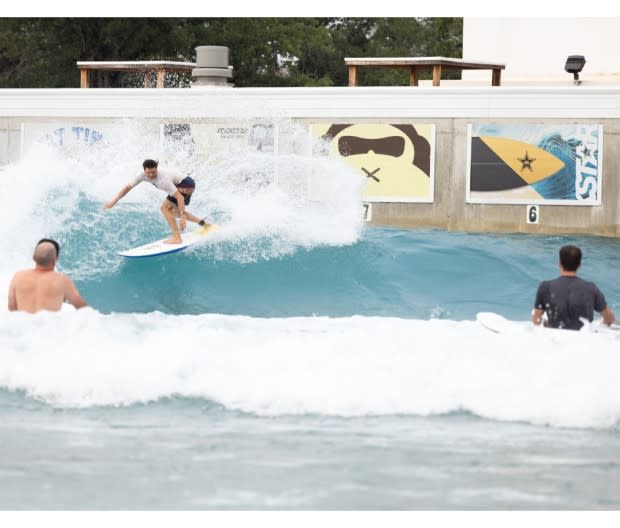
Courtesy image
Waco, TX
Texas had never traditionally been a surfing destination until the Waco Surf (formerly BSR Surf Resort) wave pool opened to the public in 2018. Suddenly, the Lone Star State became a new magnet for sunburnt, bleach-headed shredders looking to score.
Waco Surf is 200 miles from the nearest ocean in a near-desert region, yet it attracts some of the world’s best wave-tamers. Five-time world champion Carissa Moore trained there before she won a gold medal at the 2020 Tokyo Olympics. Air-style masters Mason Ho, Nathan Florence, and Josh Kerr are regular visitors.
While Slater’s Surf Ranch is only for the lucky few, Waco Surf hosts public sessions for anyone to book. You’ll line up and take turns catching waves with between nine and 12 surfers. Everyone gets a chance to surf both forehand and backhand with half an hour on both rights and lefts. You can even reserve the entire pool for an hour with your friends. A one-hour session in intermediate waves costs $130 per person, while experts hoping to ride those perfect overhead peelers need to fork out about $300.
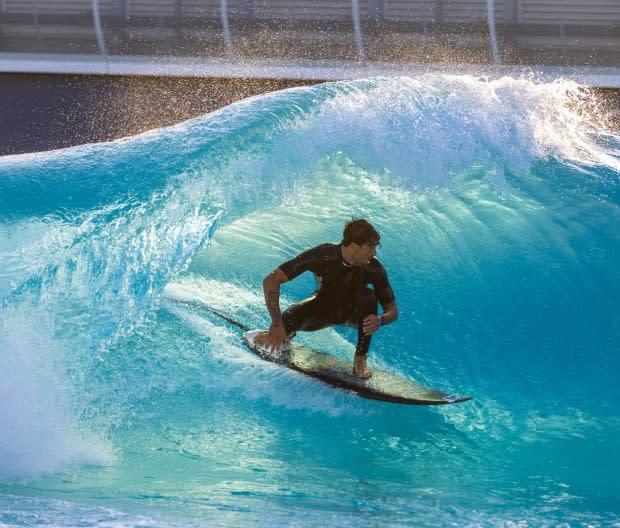
Courtesy image
Melbourne, Australia
Australia is known for its plentiful waves and gorgeous coastlines, but the artsy southern city of Melbourne is not necessarily top of list for surf travel. URBNSURF changed that when it opened in 2020, bringing waves to the urban sprawl and making Melbourne’s city outskirts an unlikely hotspot for surf missions. About a 10-minute commute from the international airport, you can literally fly in, Uber to the pool, get shacked, then fly out in as little as half a day.
Choose from beginner, intermediate, or advanced wave sessions that run for an hour with up to 18 surfers on each side of the pool. In contrast to the Waco pool, URBNSURF operates two “sides” which are effectively their own pool—one sending left-hand waves, the other for rights—so you can spend an entire hour on your forehand if you prefer. After your wave, simply paddle into the channel that pulls you back out with a current like a riptide in the ocean.
In a one-hour advanced session you can expect to ride 12 perfect barrels for just $80. Plus, it’s worth sticking around to dig into avocado smash, zingy margaritas, or a gourmet burger at the iconic Australian restaurant onsite, Three Blue Ducks, which originated in Australian surf mecca Byron Bay. URBNSURF is the first surfable wave pool in the Southern Hemisphere but is preparing to launch an exciting second site in Sydney in 2023.

Courtesy image
Sion, Switzerland
Tucked into a spectacular setting below the Swiss Alps is Ala?a Bay—the first wave pool of its kind in continental Europe. It’s also likely the most scenic spot anywhere to slash turns on artificial peelers. Where else can you score endless barrels in the shadows of snow-capped mountains?
It may seem obvious from all the snow around, but this pool gets quite chilly in winter. Prepare for between 40–50-degree water if you’re surfing in January or February, with air temperatures peaking at about 50. Fortunately, the site is well-prepared, offering winter wetsuit kits with hoods, gloves, and booties, plus steamy showers and change rooms to thaw out afterwards. In summer, Switzerland can be balmy, and the pool water warms up to the 70s. You’ll be catching at least 10 waves in an hour session, which should help keep the warm blood flowing.
Want to ski and surf some of the world’s best conditions in both sports on the same day? It’s possible here. Ala?a Bay is less than 30 minutes by car to the colossal Verbier 4Vallées ski area.
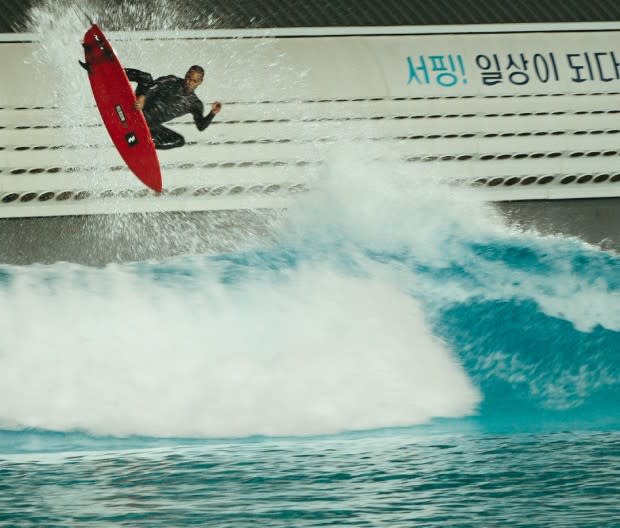
Courtesy image
Siheung, South Korea
Seoul surfing is now a thing at Asia’s largest wave park, which opened in 2020. Wave Park is under an hour’s drive from South Korea’s capital city, and about half an hour from the international airport.
Related: Lift Foils’ Latest Model Takes Hyrdrofoil Surfing to New Heights and Speeds
The Asian peninsula country has never registered on surf travel maps before, being surrounded by sizeable land masses (like Japan, China, and Russia) that prevent swells from reaching its shores. The actual location of the Wave Park is unremarkable—a former industrial zone across the water from Incheon, but that’s also what makes it exciting. There are plans to develop the entire area into a luxury marine complex with hotels, stores, restaurants, and residential areas.
Wave Park uses the same technology as URBNSURF, so you can expect the same perfect rides, but at a fraction of the cost—just $60 to surf the concrete “reef” for an hour. There’s also a much larger “bay” area to accommodate newbies on the more beginner-friendly, rolling wave setting. A rarity with wave pools, the water is heated to never drop below about 60 degrees.
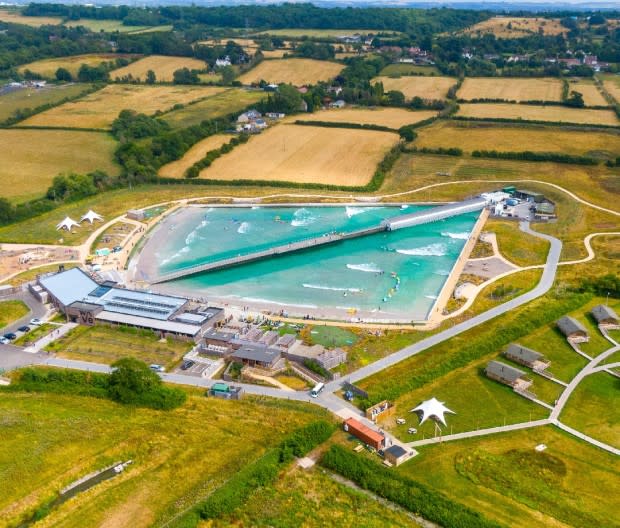
Courtesy image
Bristol, United Kingdom
England isn’t exactly a pipe dream for traveling surfers. The swells are fickle, beaches are rocky and conditions less than idyllic. However, unbeknownst to many, this wave pool in a seaside region of southwest England has been quietly creating dreamy pipes since it opened in 2019.
The wave pool is the size of four football pitches and produces a wave using the same tech as Wavegarden and URBNSURF. Choose from intermediate rollers to sharp, fast tube rides. Waves come every 10 seconds in sets of 12, in the two-to-four-foot range. You can take advantage of England’s long daylight hours when the pool opens from 6 a.m. to 11 p.m. in the summer months when water temperature hovers in the 70s. In winter, you’ll need a rubber layer. Old Blighty is known for its temperamental climate. But if you’re willing to risk it, the British biscuit is cheap: only about $60 for an adult one-hour session.

Courtesy image
Yeppoon, Australia
In the tropical northern Australian town of Yeppoon, legendary former world champion surfer Mark Occhilupo (“Occy) and his friend and wave park founder Aaron Trevis have been experimenting with technology that can create four rippable waves at a time. It’s known as “the plug” for the enormous plunger that dunks into the centre of a man-made lake, unleashing monster ripples out from the midpoint—creating waves on four sides. Unique underwater “reefs” create a range of shapes to cater to all skill levels.
Surf Lakes is currently a research and development facility, but the technology has already been licensed to a handful of buyers around the world. Seven sites are planned across the U.S. in Los Angeles and Riverside, CA, Dallas and Austin, TX, Tampa, Charleston, SC, and of course Las Vegas. No news on the timeline for when these will open, but Surf Lakes insiders have told us the new pools will be quieter, produce more than 2,000 rides every hour, and the rusty plunger will be a sleek steel plug finished with architectural aesthetics.
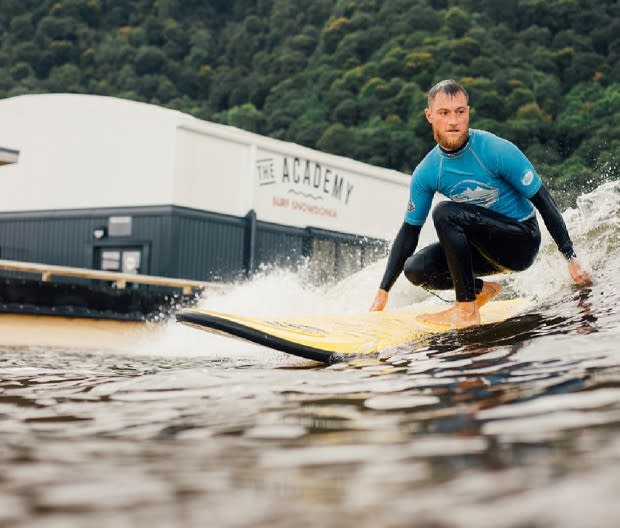
Courtesy image
Wales, UK
Leave it to Wales to introduce the world’s first inland surf lagoon. It opened in 2015 and sent waves peeling across a random Welsh puddle miles away from the coastline, to the stunned awe of surfers everywhere. The pool generates a six-foot blank canvas for 16 seconds of memorable shredding time.
Surf Snowdonia spurts out incredibly rippable, fun walls, but they’re not as pacy or hollow as the tube rides in newer pools like URBNSURF or Waco. Chalk that up to the slightly dated technology. Nevertheless, you’ll have an unreal time shredding all levels of waves that are far more consistent than anything the Welsh coastline is serving up—and for just $50 an hour. The pool is part of a bigger adventure park that includes laser tag, indoor caving, and climbing, so you can make a whole adventure holiday out of your visit.
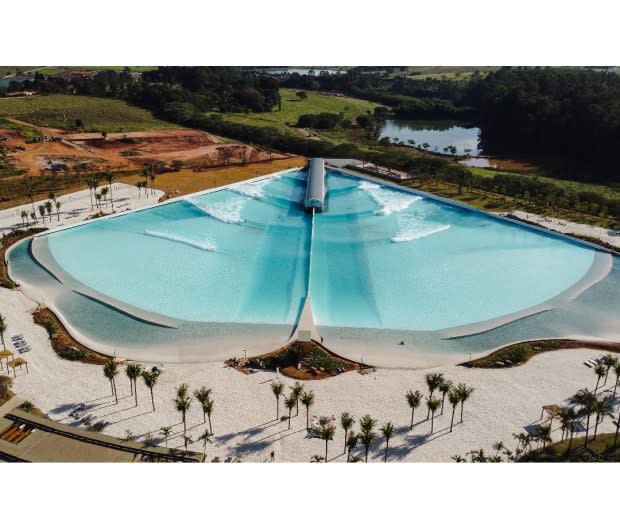
Courtesy image
Praia de Grama, Brazil
You don’t have to work in real estate to know oceanfront property is a valuable commodity. It’s why developers in Brazil decided to plonk South America’s first wave pool inside a residential complex—accessible only to the VIP residents and guests of a luxury gated community about 60 miles north of S?o Paulo.
The pool is part of Fazenda da Grama, a luxury residential development also home to one of Brazil’s top 18-hole golf courses, horse riding, beach volleyball, tennis, gym, swimming, spa facilities, and even an agroforest. Waves for the lucky locals break both left and right in a fully artificial, white sandy beach lagoon with real palm trees rimming the pool. It’s been earmarked as a new benchmark for how perfect waves might add value to the realtor sector.
If surfing in this country club-style resort doesn’t tickle your fancy (or budget), look out for Brazil’s new disruptor: a public surf center slated to open in the southern city of Curitiba in 2024. Surf Center is building the world’s first indoor wave pool there, and it’s heated. You’ll have to buy a membership (currently USD $10,000—the discounted rate) on top of monthly membership fees of about $200.

Courtesy image
Tenerife, Spain
Wave pools love to claim they generate the first, longest, or most epic waves—but only one is loudly boasting it has the biggest in the world. That one is the Wave Palace in Siam Park, a waterpark in Spain’s holiday isle of Tenerife in the Canary Islands, which claims to produce waves up to 10 feet tall.
Most of the videos and images of this pool show waves reaching about six feet max, but who’s complaining when they look this good? Looming swell lines can alternate between long runners, perfect for turns and trimming across the face, and close outs that have steep faces for practicing air maneuvers. Tweaking the settings can also send longer waves left or right, or split them down the middle with an A-frame that two surfers can ride at the same time.
The Wave Palace sends waves every 60-90 seconds, with 40-60 waves per hour. The pool can only be booked for an hour, so next time you’re in the Canaries, round up your pals and split the bill (about $670).